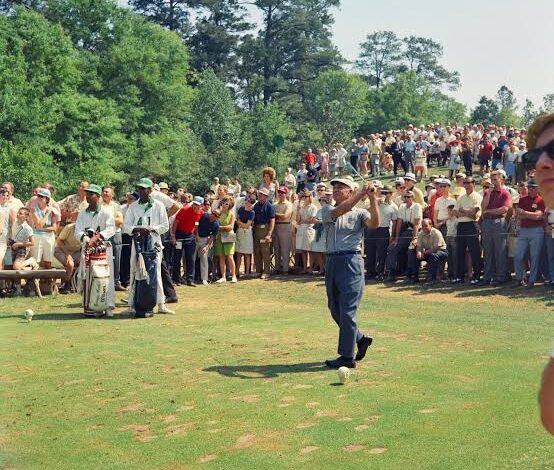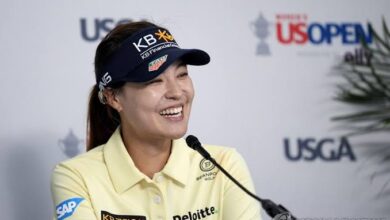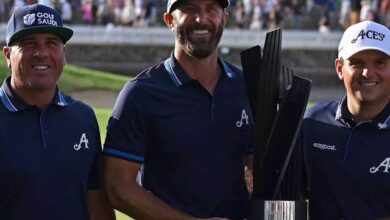Fifty seven years ago Ben Hogan made his Masters’ farewell in a very Hogan-esque way

The sweetest Masters moment for a competitor seldom described as sweet took place 57 years ago when, for two hot hours, 54-year-old Ben Hogan reminded us that despite advanced age and an advanced case of the yips, great golf still lived within him.
Although Hogan would come to be most identified with the U.S. Open, thanks in part to his starring role in two Best Tournament Ever nominees—the 1951 and 1960 versions—no one except Arnie was ever closer to Augusta’s heart. Founding fathers Bobby Jones and Clifford Roberts adored Hogan and pulled hard for him in the tournament, because they always bought him in the Calcutta, or tried to.
They even let him start his own tradition. When, after 10 tries, the Hawk finally won the damn thing, Bob and Cliff said yes to his idea for drinks and dinner at the club for the new champ and all his predecessors at the next Masters: thus, the Tuesday night Champions Dinner. And not for nothing is that the Hogan Bridge spanning Rae’s Creek on No. 12.
A reporter once asked Jones, a cerebral, perceptive man, who he’d want to hit one shot for his wife, or his life, or all the tea in China. “That’s not hard for me to answer,” Jones said. “Hogan. Hogan had the intangible assets—the spiritual.”
The Hawk had his intangible assets tested over and over in Augusta. Although he won twice, decent final rounds in 1950 and 1960 might have netted two more wins. He finished second in ’42, ’46, ’54 and ’55. Two of these were one-shot playoff losses to his main rivals, Byron Nelson and Sam Snead.
His runner-up in ’46 might have been his most excruciating finish. In the first post-World War II Masters, Hogan three-putted the 72nd green to keep from tying the darkest dark horse, the Missouri Mortician, Herman Keiser, who, for the rest of his life, raved about what a gentleman the defeated champ had been. Two months later, in the U.S. Open at Canterbury, Gentleman Ben did it again. With two putts on the final hole, he’d have tied for first. But he took three.
Which leads us to the case of Hogan v Putter. “The least attractive part of his game,” remarked writer Herbert Warren Wind chastely, referring to Ben in middle age. Although Hogan had putted brilliantly in his prime, and it wasn’t exactly like Beethoven going deaf, now, sometimes, the virtuoso froze, unable to will the putter head away from the ball. There’s tape of the jittery Hawk putting from 15 feet for birdie on the first hole, third round, of the 1960 Masters. And he left the pin in! It was legal to use the stick as a backstop when putting from the surface back then, but from five steps away, it was extraordinarily defensive.
The 1967 event would be Hogan’s final Masters. We don’t know, because he didn’t say, if he decided this would be it after the fact or before it. In either case, Augusta National’s undulant hills and icy greens were a lot to take for a man in his fifth decade, a man with poor vision in his left eye and a left knee and left shoulder that probably needed surgery, inescapable reminders of his near fatal car accident in 1949. Still he did his usual due diligence: a long warm-up at Seminole in North Palm Beach, Fla., and then an early arrival in Augusta. And cortisone injections, 17 of them in the previous year, he said.
Bruce Devlin played two practice rounds with his tough Texas friend. “He was really fun to watch, even then,” Devlin recalls. “I think that from a ball control standpoint, he was the greatest golfer who ever lived.”
In his first competition in almost two years, Hogan shot 74-73. No one noticed. He shot even par on the first nine on Saturday, April 9. No one noticed. The big story was Jack Nicklaus watching the show from a golf cart; the 1966 champion confounded everyone by being the first defender to miss the cut.
Hogan made the turn, and then the angels sang.
He struck superb irons to seven feet, one foot, and 12 feet on 10, 11 and 12—and somehow wiggled in the putts. He hit both par 5 greens in two with 4-woods. Cautious two putts put him five under for the day, pulling him close to the lead. The TV cameras found him. He wore blue. He looked old, more like 74 than 54. He limped badly.
“He was really struggling to get up the hill on 18,” CBS producer Frank Chirkinian told Golf Digest 10 years ago. “He took slow and deliberate steps … and it wasn’t because he was looking for applause, I’ll tell you that.”
Many eyes—including those belonging to Chirkinian—welled up at the sight of the brave little warhorse trudging home. But then it seemed that Hogan would ruin the moment by hitting his iron shot into the no-man’s land above the pin, leaving a downhill putt on the stair step green. Hadn’t Ben three-putted from there in ’46? Not this time. Although his wristy slap shot from 25 feet was so ugly it almost hurt to look at, the ball rolled in. That was 30 on the back, 66 for the day, pulling the tough guy within two shots out of the lead held by Julius Boros, Bert Yancey and Bobby Nichols.
He didn’t win, of course. He got standing ovations at every green the next day, but his 77 got him only a T-10. “Only” may not the right word, but for a person as severe on himself as Hogan was, 10th was never enough.
We’ll be remembering this and other vignettes this year to mark the 20th anniversary of his death. I like to imagine Hogan in time lapse at Augusta National. In his first Masters, in ’38, he was a skinny little man who had never won a tournament with his circle and a half swing. Then came glory years, green jackets, and disappointment, but no complaining. And, finally, 57 years ago, his sweet farewell.



